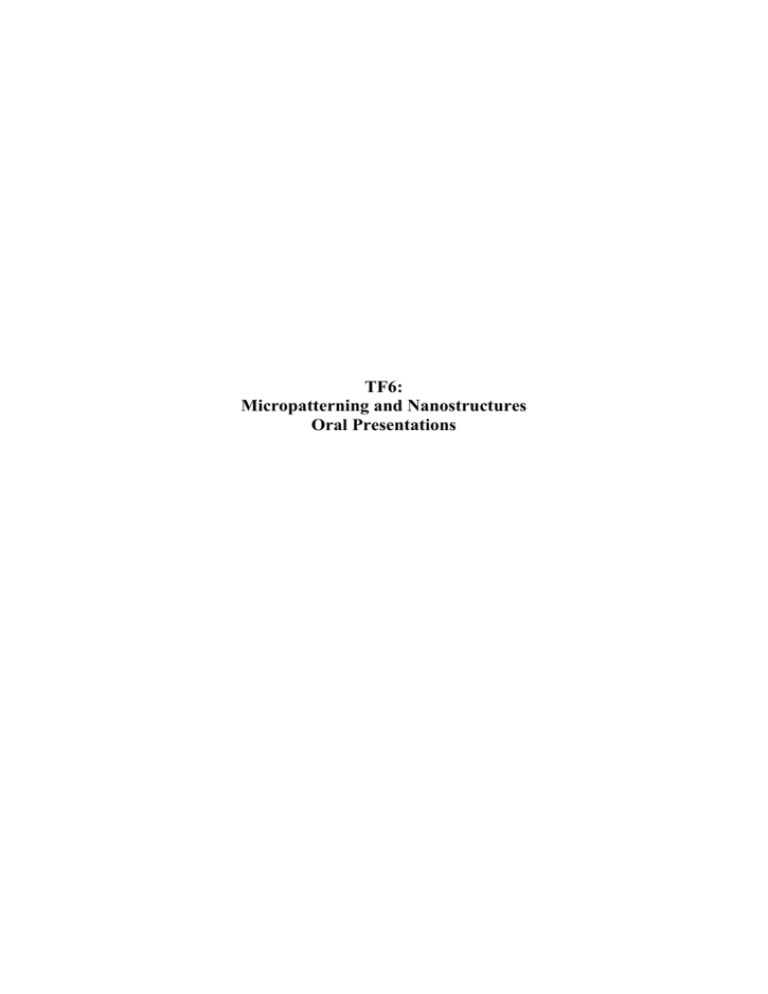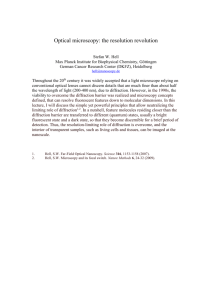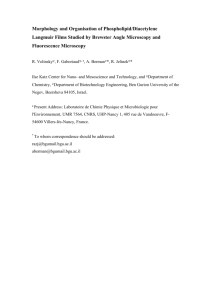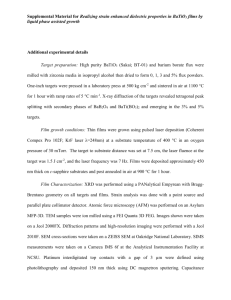TF6.O - ICTF 12
advertisement

TF6: Micropatterning and Nanostructures Oral Presentations TF6.1.O NANOSTRUCTURAL PROPERTIES OF AMORPHOUS SILICON CARBIDE BY GISAXS AND OPTICAL SPECTROSCOPY D. Gracin, P.Dubček and M.Jakšić, Ruđer Bošković Institute, Zagreb, Croatia Nonstehiometric hydrogenated amorphous silicon thin films were deposited by magnetron sputtering in a wide range of hydrogen and carbon concentrations and analyzed by vibrational spectroscopy and GISAXS (Grazing Incidence Small Angle Xray Scattering). Also, the film composition and density were estimated by IBA (Ion Beam Analysis), e.g. RBS (Rutherford Backscattering Spectrometry) and ERDA (Elastic Recoil Detection Analysis). It was found that the film density decreases with increasing carbon and hydrogen concentration. Assuming that the interatomic distance does not change substantially with the changing composition and applying effective medium approximation, optical properties in infrared part of spectra were used to examine the voids size and concentration. Using the previously proposed model, it was found that the voids sizes increase and the size distribution broadens with higher hydrogen and carbon content. In order to check above assumption and model calculation, the GISAXS was performed on ELETTRA synchrotron radiation source, Trieste (Italy). In order to independently determine the influence of surface roughness, the spectra were taken under several grazing angles. The obtained results show presence of two types of structural features with different sizes. The smaller ones have dimensions between 1-2 nm and can be identified as voids while the other ones are 10 nm large "particles" that are identified as void agglomerates. TF6.2.O Phase analysis of nano-phase materials using selected area electron diffraction in the TEM János L Lábár Research Institute for Technical Physics and Materials Science, Budapest Nano-phase materials are in the forefront of research and the large number of nanotechnology projects worldwide forecasts its increasing importance. In analogy to X-ray power diffraction (XRD), we are developing a method to help phase identification when examining a large number of grains simultaneously by electron diffraction. Although XRD is well established, it can not be used for small quantities of materials (volumes below 1 m3). Examining a usual TEM sample with thickness of 100 nm and using a selected area of 1 m in diameter, the selected area electron diffraction pattern (SAED) carries information about several thousands of grains from a material with an average grain size of about 10 nm. The accuracy of XRD can not be attained by electron diffraction (ED). However, simultaneous visual observation of the nanostructure is an additional benefit of TEM (beside the small amount of needed material). The first step of the development project was the development of a computer program (“ProcessDiffraction”) that processes digital versions of SAED patterns and presents them in an XRD-like form (intensity vs. scattering vector) [1]. In the present version (V2.0.3) phase identification is carried out by comparing the measured distribution to “Markers”, i.e. data of known phases. XRD data cards are used if the detailed structure of a phase is not known. Kinematic electron diffraction intensities are calculated for phases with known atomic positions. The program can be downloaded free from the home page of the author (www.mfa.kfki.hu/~labar/ProcDif.htm ). The talk will show the usage of the program in live in typical application situations. Beside others, the possibilities that make the new version of the program distinct from the previous one are: structure definition, ED calculation, usage of compare memories (with Save / Load functions), editable options, generation of result in a document and a brand new user interface of multiple document type. Quantification of the amounts of the phases present is planned in the next step of the development. [1] Lábár JL: “ProcessDiffraction: A computer program to process electron diffraction patterns from polycrystalline or amorphous samples”, Proc. EUREM 12, Brno (Frank L and Ciampor F, Eds.) (2000), Vol III., I379-380 Corresponding author: JL Lábár; Tel. +36 1 392-26-92; Fax.; +36 1 275-49-96 E-mail: labar@mfa.kfki.hu H-1121 Budapest, Konkoly Thege u. 29-33, Hungary; Postal address: H-1525, Budapest P O Box 49 TF6.3.O SUBPICOSECOND LASER MICROPATTERNING FOR X-RAY OPTICS A. Manousaki, D. G. Papazoglou, , I. Zergioti, R. Senderak*, Y. Chushkin*, M. Jergel*, E. Majkova*, S. Luby*, C. Fotakis Institute of Electronic Structure and Laser, Foundation of Research and Technology – Hellas, P.O. Box 1527, 711 10, Heraklion, Greece. * Institute of Physics, Slovak Academy of Sciences, 842 28 Bratislava, Slovakia. The ultrashort laser microstructuring of multilayer gratings for soft X-Ray optics is presented. A micromachining system operating with a KrF laser at 0.5 ps pulse duration and a high reduction ratio (25x) optical projection system were used to etch grating structures on Si/Mo multilayer with lateral period of 2 m. The Si/Mo multilayers were fabricated by UHV e-beam deposition onto unheated Si(100) substrates and oxidized Si(100) substrates. The nominal thickness of Si and Mo layers was 4.5 and 2.5 nm respectively. Gratings with over 100 grooves of 0.9m x 700m were fabricated at low laser fluences (< 600mJ/cm2). Optical Microscopy, Scanning Electron Microscopy, Atomic Force Microscopy and X-ray Reflectivity were used to characterize the microetched patterns. The roughness (rms) on the surface of lines and grooves increased with the depth of the grooves, from 0.5 nm to 14 nm for the full etched multilayers. The X-Ray reflectivity measurements confirmed the well-preserved multilayer structure. The scans around the 1st Bragg maximum have shown diffraction peaks up to the 3rd order on both sides with positions corresponding to the grating period. The use of sub-picosecond laser pulses minimizes the thermal affected zone and enhances the quality of the etched features. The ultrashort laser micromachining is advantageous for the fabrication of high spatial resolution microstructures required in the X-Ray optics industry. Corresponding author: manousa@iesl.forth.gr tel:0030-810-391126 TF6.4.O CYTOCHROME P4501A2 NANOSTRUCTURING FOR SENSOR APPLICATIONS Mirco Antonini, Paola Ghisellini, Cristina Paternolli and Claudio Nicolini Department of Biophysical M&O Sciences and Technologies, University of Genova, Corso Europa, 30 16132 - Genova (Italy) Tel. +390103538541, Fax +390103537584 e-mail: mirco@ibf.unige.it Cytochromes P450 are a large superfamily of heme-thiolate enzymes involved in the metabolism of many different organic substrates as drugs, fatty acids and toxic compounds (1). Immobilization techniques preserving the functionality of the molecules were realized in order to use the potential properties of these enzymes in biosensors and bioelectronics (2). The cytochrome P450 monooxygenase system has a fundamental role in the metabolism of a large variety of exogenous and endogenous hydrophobic compounds, including drugs, chemical carcinogens and co-carcinogenens. In order to optimize biodevice assembly for a possible biosensors application, thin films of cytochrome P4501A2 were realized and characterized. This enzyme plays a critical role in the metabolism of the sex hormone estradiol, aromatic amines, caffeine and certain drugs. For its properties, this cytochrome is a potential active enzyme for drug monitoring and it has particular importance for clinical psychopharmacology. The thin films were realized utilizing different techniques: Langmuir-Schaefer (LS) immobilization and spreading on screen printed rhodium-graphite electrodes . The characterization of the LS films was performed by means of spectrophotometry, circular dichroism and Brewster Angle Microscopy. Preliminary analysis of the P450 films functionality was realized by spectrophometric characterization, monitoring the cytochrome spin-state transitions. Cyclic voltammetry was performed in order to test the interaction between the immobilized cytochrome and its substrate (clozapine). The aim of the work is to compare the different techniques of deposition utilized to obtain cytochrome P4501A2 nanostructuring and to employ the realized samples for the realization of a biosensor for the dope detection. References (1) C. Paternolli, P. Ghisellini and C. Nicolini, “Development of immobilization techniques of cytochrome P450-GST fusion protein”, Colloids and Surfaces BColloids and Surfaces B, 23, 305-311, 2002. (2) C. Nicolini, V. Erokhin, P. Ghisellini, C. Paternolli, M.K. Ram and V. Sivozelhezov, “P450scc engineering and nanostructuring for cholesterol sensing”, Langmuir, 17, 3719-3726 2001. TF6.5.O Supersonic cluster beams: a powerful method for the deposition of nanostructured thin films with tailored properties Paolo Milani INFM-Dipartimento di Fisica, Universita’ di Milano Via Celoria 16, 20133 Milano, Italy Deposition of clusters from the gas phase has been proposed as an interesting technique for the synthesis of controlled nanostructures on surfaces. Among different experimental approaches, supersonic clusters beam deposition has been shown as a viable route for the production of nanostructured systems ranging from organized nanoislands to nanostructured thin films. To this goals the development of highly intense cluster source is a necessary requisite together with the capability of size selecting the aggregates prior to deposition, while maintaining high particle fluxes. By using a pulsed microplasma cluster source and by exploiting aerodynamical effects typical of supersonic beams it is possible to obtain very high deposition rates with a control on neutral cluster mass distribution, allowing the deposition of thin films with controlled nanostructure. Due to high deposition rates, high lateral resolution, low temperature processing supersonic cluster beams can also be used for the micro and nanopatterning of cluster-assembled films when little or no post-growth manipulation or assembly is required. For example the nano and mesostructure of films obtained by carbon cluster beam deposition can be controlled by selecting in the beam the elemental building blocks, moreover functional properties such as field emission can be controlled and tailored The use of supersonic cluster beams opens also new perspectives for the production of nanostructured films with novel physico-chemical and topological properties such as nanostructured carbon matrices containing carbide and transition metal particles. Few examples will be discussed. TF6.6.O CHARGE STORAGE IN Si-IMPLANTED SiO2 LAYERS EXAMINED BY SCANNING PROBE MICROSCOPY Reinhard Beyera, Elke Beyreuthera, Johannes von Boranyb and Jörg Webera a TU Dresden, Institut für Tieftemperaturphysik, D-01062 Dresden b Forschungszentrum Rossendorf, Institut für Ionenstrahlphysik und Materialforschung, PF 510119, D-01314 Dresden Embedded nanoclusters in thin insulating layers are key components for prospective memory devices, and ion beam synthesis is a promising technique for their generation. At present, however, the electronic structure of clusters in oxide layers and the charge storage mechanism are not well understood. Here we report on the examination of the charge trapping in silicon implanted SiO2 layers using scanning capacitance microscopy (SCM) and scanning force microscopy (SFM). Silicondioxide layers on (100)Si with a thickness of 25 nm were silicon implanted with different doses and subsequently annealed at high temperatures (1050°C/1150°C). The formation of Si-rich regions as well as of Si-nanoclusters has been verified by Rutherford backscattering (RBS) and transmission electron microscopy (TEM). Charge injection into the insulating layer was accomplished by applying a bias between the conductive probing tip and the substrate. Local as well as scanning injection in quadratic areas was performed in the contact mode. SCM images taken at different times after injection show the charge pattern and their retention characteristics. For a quantitative estimate of the trapped oxide charge densities the shifts of the local capacitance voltage curves (C-V) were evaluated. Differences are caused by the sample parameters (substrate, implantation dose, annealing) and by the injection conditions (bias, polarity, injection time). The strongest trapping effect was found for heavily Siimplanted (2x1016cm-2) SiO2 on p-substrate and +10 V write bias at the tip. Complementary information about local trapping was obtained from SFM images. Sequences of voltages with different polarity were used to study the trapping/detrapping kinetics. A multitude of write/erase cycles served as local dynamic electrical stress, allowing to compare the degradation and the programmability of the different oxide layers. Corresponding author: Reinhard Beyer, TU Dresden, Institut für Tieftemperaturphysik, D-01062 Dresden, Tel.: +49-351-463-33637; Fax: +49-351-46337060; e-mail: Reinhard.Beyer@physik.tu-dresden.de






